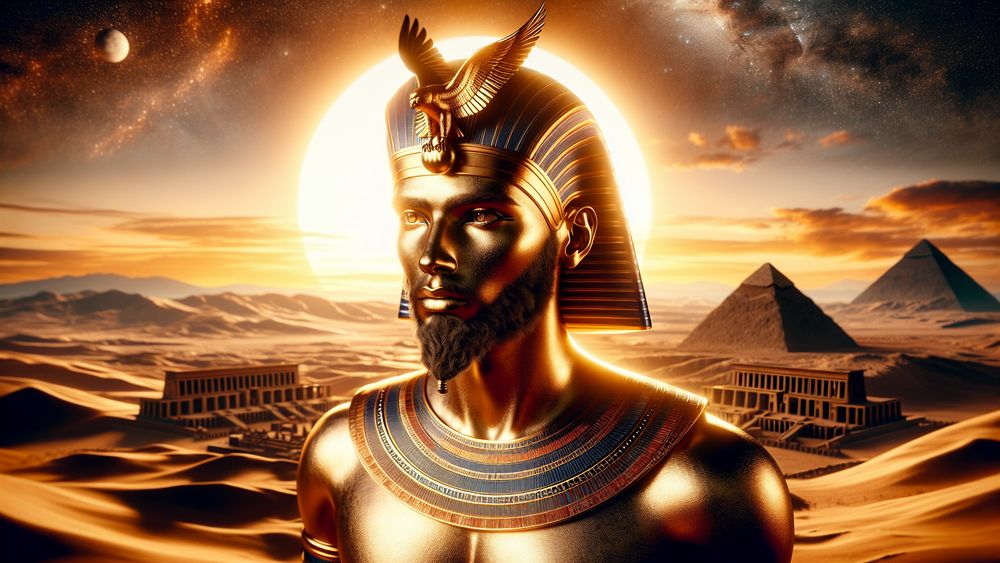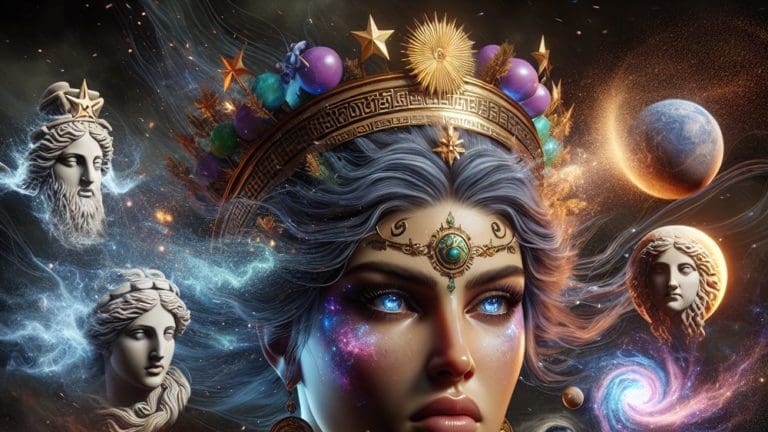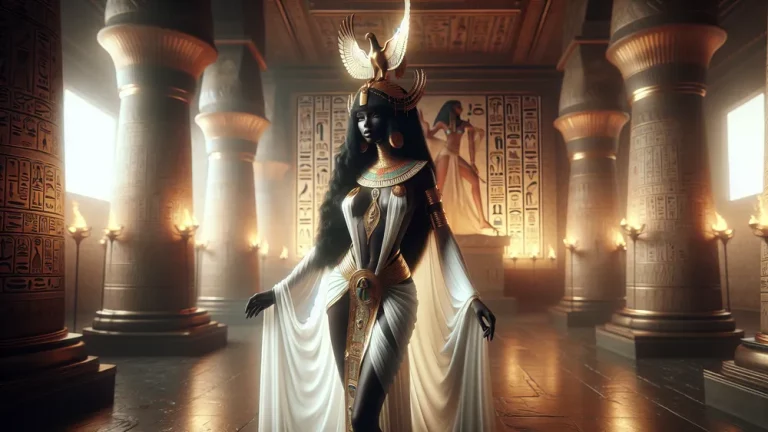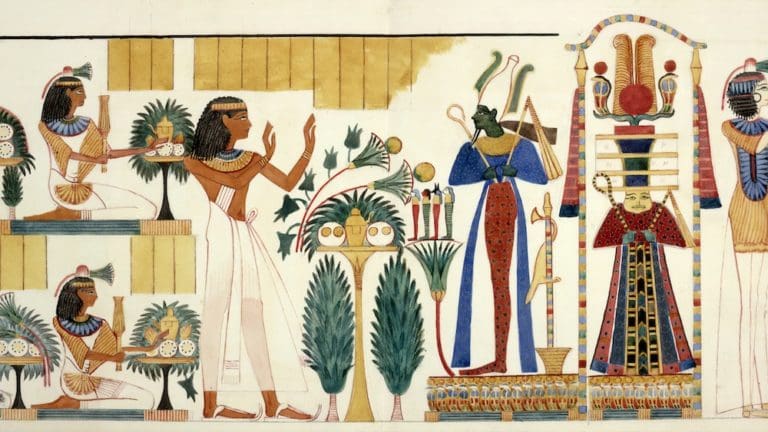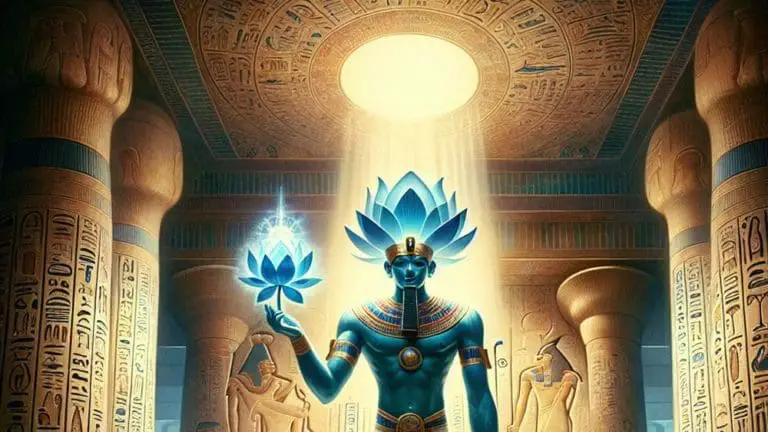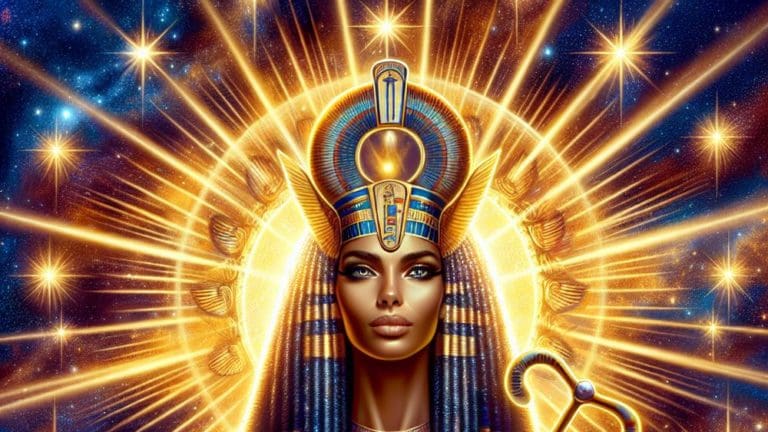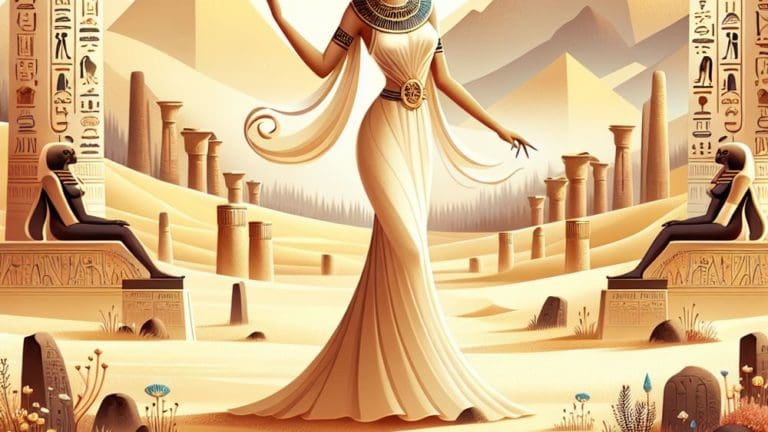Atum: Ancient Egyptian Sun And Creator Deity
So, we’re talking about Atum here. He’s a pretty major figure in ancient Egyptian beliefs. Think sun and creation all rolled into one god. This guy is at the heart of how the Egyptians saw the world starting and how everything keeps ticking. Atum isn’t your everyday deity.
Key Points:
- Atum, an ancient Egyptian deity, symbolizes both the sun and creation.
- Atum is a central figure in Egyptian mythology, representing life, death, and cyclical renewal.
- Atum is key in Egyptian cosmology, creating gods and the world from chaos.
- Atum is worshipped through symbols like the Red Crown and the Bennu bird.
- Atum’s worship involved grand temples, particularly in Heliopolis.
- Atum is part of the Ennead of Heliopolis and evolved in significance over time.
- Atum’s legacy endurances in modern culture through art, media, and literature.
He’s got a lot going on, being all about life, death, and everything coming back around again. Diving into Atum’s story, we get to see how the ancient Egyptians made sense of where they and their gods came from. He’s more than a simple character in their tales.
Through Atum, we really get into the nitty-gritty of Egyptian thought, their religious practices, and how they saw the universe. We’ll walk through what made Atum so special, how people showed their respect for him, and the mark he left on Egyptian culture. And yes, we’ll even see where he’s popping up today.
Who Is Atum?
So, we’re heading straight into the heart of the matter. Let’s take a very close and detailed look at Atum, figuring out precisely who he is and the role he plays in the grand narratives of ancient Egyptian mythology.
The Origins and Meaning Behind Atum
So, let’s talk about Atum. His name comes from the word ‘tm’ in the language of ancient Egypt. This word means “to complete” or “to finish”. It directly ties to what Atum does best: finishing the world which he himself starts from nothing but chaos.
He’s a key player in Egyptian myths, standing for both the end and the start of life and everything that exists. His job in the mythology of Egypt? Huge. He’s the one who did it all first, creating gods and the world by simply being. The very old writings called the Pyramid Texts, which go way back to around 2400-2300 before our time, are where we first hear about Atum.
These writings really put a spotlight on how crucial Atum is for making and keeping the universe going.
- The name of Atum shines a light on his role as both the universe’s creator and its finisher.
- The Pyramid Texts, which are super old and very special, are where we first get to meet Atum and see his importance.
- When Atum comes into play, he rises from Nun, which is all about the start of order from a messy beginning.
So, we see that Atum isn’t your everyday deity. He literally starts everything from scratch and makes sure it all runs smoothly after that. And those ancient texts? They’re like a direct line to seeing how people back then saw the world and its beginnings.
Atum’s Place in the Egyptian Creation Myth
When we look at how Atum fits into the Egyptian story of the beginning, it’s quite a tale. He starts everything off, literally coming from nothing, which is quite a feat if you think about it. He doesn’t need anyone or anything to make himself. He simply decides to be and so he is.
After that, he gets busy making everything else. First, he brings into being Shu and Tefnut by either spitting or using his hands in a way that’s rather unusual for us but made total sense for them. These two then go on to have kids of their own, Geb and Nut, which keeps the ball rolling.
So, from one, we get many. It’s a story that keeps on giving. Now, if we turn our gaze to other cultures, we see bits and pieces that feel familiar but also quite different. Take for example Chaos from Greek tales or Ymir from Norse legends. They’re somewhat like Atum because they’re at the start of everything too.
Yet, how they go about bringing everything else into existence isn’t quite the same. While Atum uses thought and action, Chaos and Ymir are more about the natural progression of events leading to creation. The way Atum’s story is told, it’s all about beginnings and how everything is connected back to that first moment of thought and action. It’s a loop where everything starts and ends with him.
The Symbolism and Worship of Atum
So, after digging into how Atum kicks off the whole creation show, we pivot. Now, we’re heading into how people back then showed their respect and thought about this god. They use symbols and rituals, which is pretty neat. Let’s get into that.
Symbols and Icons Associated with Atum
In the stories that come from ancient Egypt, Atum gets shown through many symbols and icons which mean a lot and carry heavy importance. One key symbol, the Red Crown of Lower Egypt, shouts out Atum’s job as a creator and his rule over the land. This crown, while mainly saying he rules over Lower Egypt, also screams unity under a divine leader for all of Egypt.
Another major symbol, the Bennu bird, links tightly to Atum because it talks about rebirth and starting again. This bird tells us about life’s cycle and the idea of getting a fresh start, which sticks closely to Atum’s story since he’s the god who kicks off life and order from a mess. Also, Atum often gets shown as a serpent, which whispers about his never-ending life and timeless nature.
This snake imagery ties Atum to the underworld and what comes after life, pushing forward his role as a protector for those who’ve passed and a guide for starting anew.
- The Red Crown, also known by “Deshret,” was something pharaohs wore to show they’re in charge of Lower Egypt before the whole country came together.
- The Bennu bird sometimes gets compared to the phoenix we know from Greek stories, which talks about rising from ashes and beginning again.
- Showing Atum as a serpent often has him coiled and ready which may show his power to protect but also to bring change and shake up the status quo.
Symbols and icons in ancient Egyptian stories reveal Atum’s role as a creator, ruler, and protector, emphasizing themes of unity, rebirth, and eternal life.
The Cult and Temples of Atum
So, when we talk about Atum and where people used to worship him, it’s mainly about these huge and impressive buildings called temples. These places were more than buildings; they were where heaven and earth could meet, according to the people back then. The biggest spot for Atum’s fans was in a place called Heliopolis. Imagine a massive complex where almost everything was about celebrating Atum.
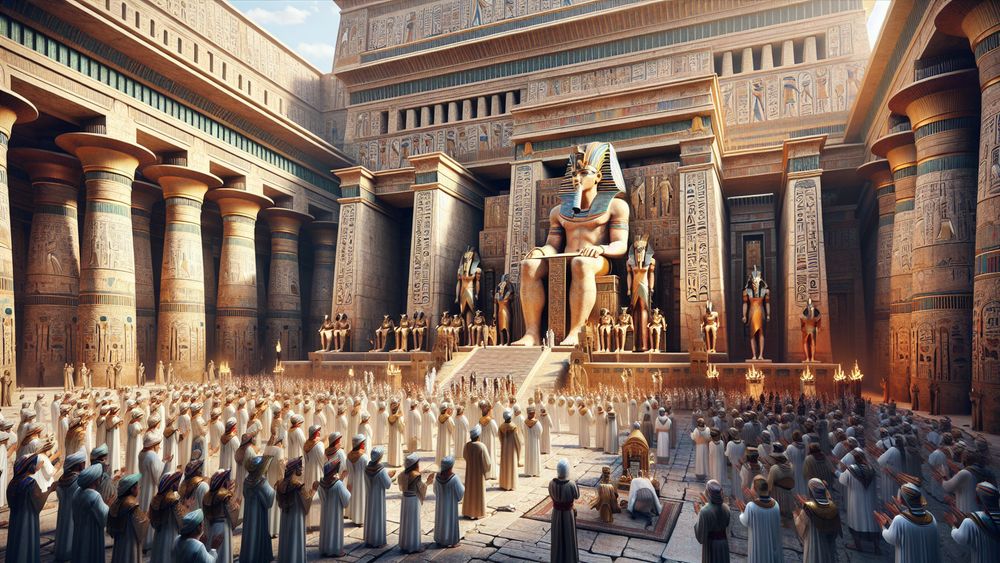
Although what’s left of it now doesn’t show its past glory, it was a key spot for rituals and connecting with the divine. Here, people brought gifts, sang songs, and said prayers hoping to keep the god and the world in good balance. The folks running the show were the priests, acting as the go-between for the everyday person and Atum.
They made sure everything in the temple pointed back to that story of how Atum started it all, especially with how they built the place to look like the chaos from which Atum emerged.
And here’s a quick look at where people celebrated Atum and what made these spots special:
| Temple | Location | Significance |
|---|---|---|
| Great Temple of Atum | Heliopolis | This was where it all happened for Atum’s followers. The design and everything about it reminded people of Atum’s creation story. |
| Karnak Temple Complex | Thebes | While mainly for Amun, this place also had spots for Atum, which showed how all these god stories were connected. |
| Temple of Atum at Per-Tem (Pithom) | Tell el-Maskhuta | This spot has a lot of history and ties to stories like the Exodus. It became a key place for Atum especially during a time called the New Kingdom when they either built or made it a lot bigger. |
So, these temples and their ceremonies were all about keeping everything in balance, which they thought was thanks to Atum’s first act of making the world. It’s a way for us to see how much effort and belief went into honoring such a deity.
Atum’s Role in Egyptian Cosmology and Society
So, after we’ve dived into the symbols and the grand buildings that bring us closer to Atum, it’s time for us to pivot. We’re heading into a space where we can see how he really fits into the bigger scene of what ancient Egyptians thought and how they structured their lives.
Atum and the Ennead of Heliopolis
Atum indeed takes up a key spot in the Ennead of Heliopolis. This group, which includes nine gods, sees Atum as its starting point. Interestingly, he brings himself into being and then goes on to create Shu, the air god, and Tefnut, the moisture goddess. He does this through somewhat unusual means: either by spitting or by using his own hands for self-pleasure.
This action sets off a chain that leads to the birth of other gods like Geb and Nut, and eventually Osiris, Isis, Seth, and Nephthys join the family. Thus, Atum sits at the heart of life’s creation and doubles as a symbol for both the sun and the very act of creation itself.
The Ennead, which he heads, is super crucial for the religion and the way ancient Egyptians organize their society. They see these gods as a divine family that represents everything in the world and the balance that keeps it all running smoothly. People back then really lean into this idea, especially when it comes to their rulers. Pharaohs often get viewed as if they are Atum’s representatives on Earth.
This belief cements their authority and their role in keeping everything in balance, which they call ma’at. So, in a way, Atum and his divine family are at the very heart of ancient Egyptian culture, influencing everything from their religious practices to how they see their leaders.
The Evolution of Atum’s Worship and Its Impact on Society
So, let’s talk about how people’s love and respect for Atum changed over a really long time in ancient Egypt. This change wasn’t quiet; it actually spoke volumes and helped mold the society and culture back then. In the beginning, everyone mainly looked up to Atum as the top god, especially around Heliopolis. This place was like his home base.
But as time marched on and Egypt itself went through a bunch of changes, so did how people felt and showed their respect for Atum. They even started to blend him with Ra, another super-important sun god, which was a huge shift. They called this combo Atum-Ra. This mix and match of gods wasn’t random.
It actually showed how people were trying to bring together different ideas and beliefs, which kind of mirrored how Egypt itself was coming together, with its upper and lower parts unitally ruling. Moreover, Atum didn’t stay in a bubble. He got linked with other gods like Osiris and Isis, which really showed how flexible and open the Egyptians were when it came to their gods and religious practices.
This blending and bending of beliefs did a lot more than people might think. It wasn’t simply about which god was in charge; it was about bringing everyone together under a shared set of beliefs and practices which, in turn, made the ruler’s word as good as divine and kept society tight-knit.
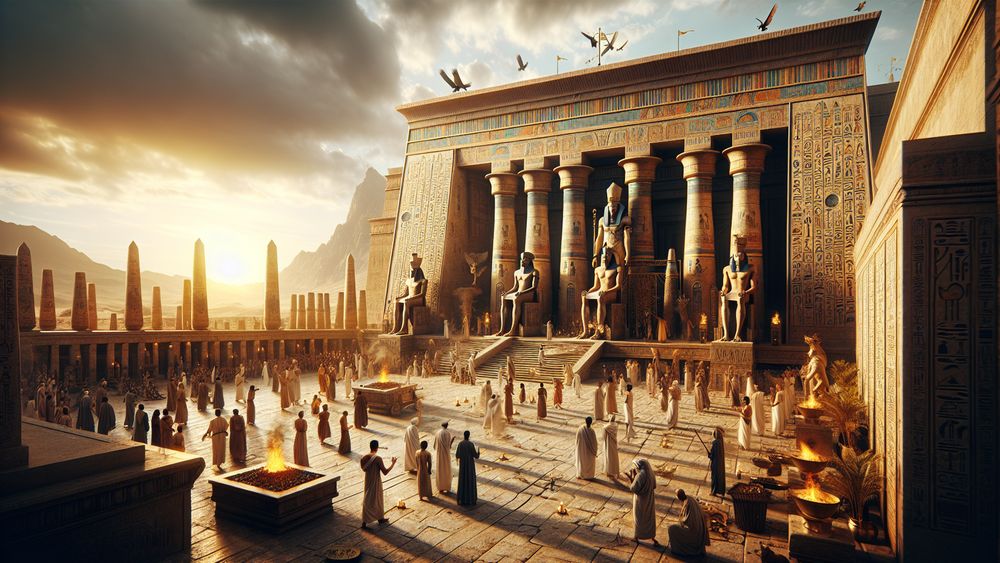
Atum in Art and Modern Culture
So, after we’ve dug into how Atum’s role and importance have shifted and grown within the ancient Egyptian community, let’s pivot. Now, we’re heading into a space where we see how artists have pictured this deity and how his story keeps touching our world today.
Depictions of Atum in Ancient Egyptian Art
When we look at ancient Egyptian art, we often see Atum shown in ways that really bring out his key roles and the many hats he wears in mythology. He often appears as a man wearing the Double Crown, which is a pretty clear nod to his top spot over both Upper and Lower Egypt.
This look isn’t random; it tells us loud and clear that he’s a major player, the kind who gets to call the shots and kickstart the whole creation gig. Then, there’s the times when Atum takes on a serpent form. Here, he’s all about the after-hours club of the underworld and the whole idea of starting fresh and keeping the cycle going.
It’s like he’s saying, “Hey, after every sunset, there’s a new dawn.” And don’t forget when he rocks the lion look or when he’s got a lion’s head. That’s when he’s flexin’, basically shouting that he’s got the muscle to protect and fight off any chaos that tries to mess with the natural order until the sun decides to rise again.
- Man with the Double Crown: This screams, “I’m in charge here and I kicked off this whole world-building project.”
- Serpent form: This is him telling us about the endless loop of endings and fresh starts, and his chill vibes with the afterlife.
- Lion or lion-headed figure: Here, he’s all about strength and being the guardian that keeps the night safe until daylight can make its comeback.
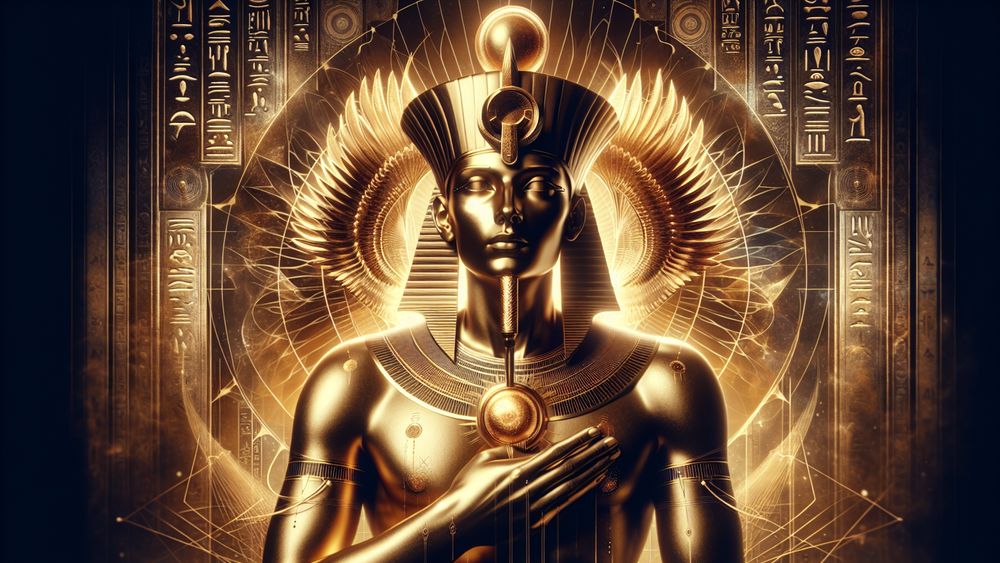
Pantheon of All the Egyptian Mythology Gods
So, when we talk about Egyptian mythology, it’s like opening a huge book filled with stories that span from the sky to the underworld. We’ve got gods and goddesses for almost everything you can think of. There’s Atum, who kicked off the whole creation gig, and then you have Isis, who’s all about protection and magic.
Don’t forget Osiris, who rules the afterlife like a boss. Each one of these divine beings brings something special to the table. And if you’re itching to get the lowdown on every single one of these celestial characters, well, there’s a place for that. Just hit up this link for a full rundown on all the Egyptian gods. Trust me, their stories are as varied as they come, and absolutely worth a look.
FAQs
1. How was Atum different from other Egyptian creator gods?
Atum indeed sets himself apart from his divine counterparts because he literally comes into being by himself and, from nothing but the endless, dark waters that existed before everything, he brings into existence the universe and all the other deities.
2. What are the most famous myths involving Atum?
So, when we talk about Atum, two stories really stick out. First, he brings the world and all the gods into being from nothing but endless waters. Then, he changes himself into the sun god Ra.
3. Can Atum be equated with the sun god Ra?
Yes, indeed, Atum and the sun god Ra often blend into one entity in the stories that come from later periods of Egyptian history. They call this combined form Atum-Ra.
4. How do modern Egyptians view Atum and his mythology?
Today, people in Egypt see Atum and the stories about him as an essential piece of their cultural and historical identity. They don’t practice this belief in their daily religious lives anymore, though.

